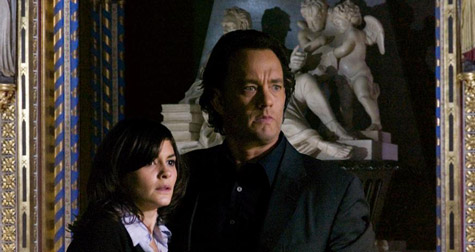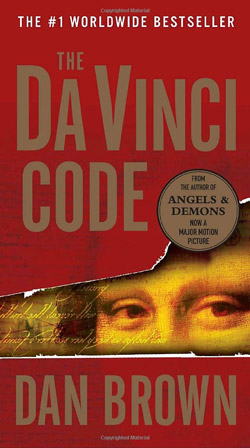
With the final film in the Robert Langdon trilogy, Inferno, hitting theaters recently, we thought it'd be apt to explore the history and mythology of a series so steeped in it. Over the course of the next 3 days, we'll explore each story—The DaVinci Code, Angels & Demons, and Inferno—and the mythology that help shape and create such a controversial series!
Dan Brown’s The DaVinci Code certainly shocked readers and viewers with its arrival and assertions about the Catholic Church. It pushed ideas that had not seen the light of day for centuries, and people started asking questions—specifically about Mary Magdalene.
Who was she really? And what about her gospel?
There actually is a gospel of Mary—one of several gospels that were excluded from the Bible, such as the Infancy Gospel of Thomas, the Acts of Paul, and even the Gospel of Judas Iscariot.
The Mary that Teabing talks about is a Mary surrounded by lots of wild speculation, especially concerning the idea of Mary as the Holy Grail. While certainly the cup was a symbol of femininity, sometimes a cup is just a cup. After all, we have to consider Christ’s reference to drinking from a bitter cup in Gethsemane; I highly doubt he was talking about Mary in those circumstances.
 So, what do we really know about Mary and her gospel? The DaVinci Code does get some things right. Foremost, Mary was not a prostitute. She is mentioned shortly after the story of the prostitute about to be stoned to death—the one Christ famously tells to “go and sin no more”—but mentioning Mary in proximity does not make her the same woman as the prostitute.
So, what do we really know about Mary and her gospel? The DaVinci Code does get some things right. Foremost, Mary was not a prostitute. She is mentioned shortly after the story of the prostitute about to be stoned to death—the one Christ famously tells to “go and sin no more”—but mentioning Mary in proximity does not make her the same woman as the prostitute.
Like so many verses in the testaments, they are often succinct stories that quickly move on to the next without much transition or preamble. Hey, paper and ink were expensive back then; no need to waste it on a lengthy bit explaining what’s going on. They just jump to the important stuff.
So Mary Magdalene was a follower of Christ. Not surprising—he had hundreds, not just the twelve. Was she considered one of them? That’s more difficult to answer. The twelve disciples were twelve because it was symbolic of the twelve tribes of Israel. Later, in Luke 10:1, Jesus “appointed seventy others and sent them on ahead of him in pairs” to teach.
It’s not necessary for Mary to be counted in one specific group or another, so long as she was a follower of Christ. There can be no doubt that she was in the inner circle, as she was the one who washed and perfumed Christ’s feet, demonstrating how important the relationship was. However, there’s nothing to suggest that she and Christ shared a romantic relationship.
The supporting evidence from the painting of the Last Supper is fanciful speculation. Feminine features on men are not unheard of. Moreover, transposing the figures so that the feminine form of John would be leaning on Christ is just manufacturing evidence, and if you’re going to play with the painting of the Last Supper, you should put in Mel Brooks holding up the halo behind Christ.
However, all of this assumes that Leonardo DaVinci—who painted the work around 1498—would have had access to this secret knowledge and believed enough in it to include it in the painting. Given how rational DaVinci was and that this would contradict edicts of Rome, it’s doubtful. DaVinci knew better than to step into the Spanish Inquisition (whose weapons were fear and surprise and a comfy chair).
Mary’s Gospel is another matter. Here we have a text, authentically dated to the second century AD. So, if we have this text, which is in the chronological range for other Biblical texts, why was it excluded? Many religious scholars suggest that Mary’s gospel was excluded because she was a woman. While certain people in the early Church had problems with women, Mary’s Gospel suffers from many problems. What we have of the text is incomplete. The majority of the text did not survive, especially the most important part concerning a vision given to her—exclusively—by Christ.
![By Alexander Andreyevich Ivanov - [1], Public Domain, https://commons.wikimedia.org/w/index.php?curid=1592262](https://www.criminalelement.com/wp-content/uploads/2016/11/mary-magdalene-jesus.jpg)
And this is where we begin to run into trouble: Why would Mary receive such a vision and not one of the others, especially Peter? He was the big cheese, the head honcho, the one upon whom “Christ would build his church.” It’s not impossible for Mary to receive a vision and not Peter, but it is peculiar.
In her gospel, Peter and Andrew point this out, but Levi reminds them that “[Jesus] loved her more than us.” Being the favorite is the next big problem, but not because Mary is a woman. The four canonized gospels refer to John as beloved, not Mary. In fact, claiming to be the most favored of Christ is a tactic that takes place in many of the gospels excluded from the Bible. Even Judas Iscariot claims to be the favorite, and that it was only because of his special status that he could take on the job as the one who betrayed Christ.
While, obviously, every gospel by a disciple will chronicle individual adventures, the problem is when those individual accounts counter what the four established gospels say. With nearly every individual gospel claiming that disciple is the favorite of Christ, authenticity becomes problematic. When we look at how little of the text is left, there’s just not enough to substantiate Mary’s gospel as viable.
The DaVinci Code is a great piece of suspense fiction that deals with some interesting tidbits of history, but like with any fiction, it takes liberties with the facts. Yes, Mary followed Christ. No, she was not in the painting of the Last Supper (nor was Mel Brooks, sadly), and there’s no evidence to substantiate that she had a romantic relationship with Christ, much less that she bore him a child. This doesn’t make it a bad book or movie. Quite the contrary—now people are interested in learning a bit more of history.
Join us tomorrow for a look at the mythology from Angels & Demons!
Andy Adams is an adjunct professor of English at various colleges in the Phoenix area. He has an affectation for fedoras as they complement his villainous goatee. He’s been known to poke his head onto Twitter @A3Writer, but he’s never been big into birds. He blogs at A3writer.comabout writing, teaching, and the conquest of fictional worlds—they’re more fun than the real world.
Read all posts by Andy Adams for Criminal Element.
